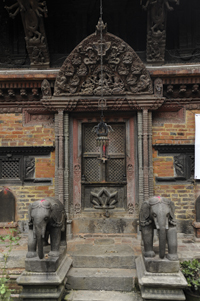The Chusya Baha is located at the end of a lane west of Kantipath and was built by Gunajyoti Bajracharya of Dhokha Baha. He was a trader whose business took him on numerous “profitable” trips to Lhasa. The inauguration of the Baha took place in 1667AD. In 1996 the Baha was restored by the Sangha with some help from international agencies and local embassies.
G unajyoti Bajracharya was one of many traders from Kathmandu valley who successfully ran businesses between the plains of India and the Tibetan plateau. The government taxed this revenue stream and used all its resources to protect and enhance this trade. The traders used the profit to design and build many monuments and elegant homes that we take so much pride in.
unajyoti Bajracharya was one of many traders from Kathmandu valley who successfully ran businesses between the plains of India and the Tibetan plateau. The government taxed this revenue stream and used all its resources to protect and enhance this trade. The traders used the profit to design and build many monuments and elegant homes that we take so much pride in.
During the peak of this trade, Kathmandu was the hub of business activities in the region. Traders from the southern plains crossed over the malaria infested jungle during winter. Traders who took these goods into Tibet had to wait till spring to cross snow laden mountain passes. This made Kathmandu the main trading center. The palaces, temples, bahas and bahis and private homes were financed by this trade revenue. Unlike leaders of today, no one lamented that Nepal was land locked; instead we took full advantage of the fact that we were land linked.
During the 1630s Nepal was able to negotiate a trade agreement that was extremely favorable for Kathmandu’s traders. Bhim Malla led this initiative on behalf of the rulers in Kathmandu and was able to attain the following favorable conditions:
Nepali traders would be able to trade tax free. Only Nepal had the right to tax them.
Nepal had a permanent commerce consul general in Lhasa who would look after the interest of Nepali traders as well as those of Kashmiri traders.
All legal cases concerning Nepali traders could be resolved by the Nepali side only
Only Nepali currency could be used for trade and the exchange rate in gold, silver and salt was set by Nepal.
All traders between the plains and the north had to pass through Kathmandu valley and this was strictly enforced.
If any Nepali trader died, all his assets were repatriated to the families in Kathmandu.
Today, as part of the global survey of 142 countries to see how competitive they were, Nepal falls into 125th place. Switzerland and Singapore, which our politicians constantly like to use as countries that we would look like under their leadership, head the list as the most competitive. Let us hope we draw some inspiration from Bhim Malla. We live between two markets with over two billion people whose economic growth rate averages 6-10 percent per annum. How much do we really need to renovate and re-build Kathmandu?
Bhim Malla returned to Kathmandu in the late 1630s expecting a hero’s welcome. He was murdered by jealous rulers. The Bhulukha temple at Yetkha tole was built in his memory in 1641 AD and has also been renovated by the municipality. People believe we still suffer from the curse of his wife as she leaped into his funeral pyre…










